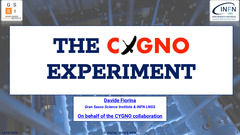The CYGNO experiment, a Gaseous TPC for directional Dark Matter searches
Davide Fiorina, on behalf of the CYGNO collaboration
The CYGNO/INITIUM project introduces an innovative approach to directional Dark Matter detection using a gaseous Time Projection Chamber (TPC). Targeting low mass (0.5-50 GeV) WIMPs, the experiment uses a He/CF4 gas mixture sensitive to both spin-dependent and spin-independent interactions at atmospheric pressure with optical readout. Building on the success of our 50 L prototype, LIME, we aim to deploy a 0.4 m³ demonstrator, CYGNO04, at Laboratori Nazionali del Gran Sasso (LNGS) between 2024 and 2026 to validate the technology's performance and scalability.
In CYGNO detectors, particle interactions ionize the gas, creating electrons that drift to the amplification stage, consisting of three Gas Electron Multipliers (GEMs). The readout system combines a scientific CMOS (sCMOS) camera and Photomultiplier Tubes (PMTs) to detect light produced during electron avalanches. This light is captured in a two-dimensional (X-Y) projection by the sCMOS camera and a time profile (dZ) by the PMTs, enabling 3D reconstruction of ionizing events. High granularity and rapid response allow detailed energy deposition mapping, supporting topology, directional, and head-to-tail recognition.
Results from LIME, which conducted data taking at the underground LNGS labs, show significant advancements in particle identification and 3D tracking capabilities. We will present these findings alongside our latest R&D progress with smaller prototypes aimed at optimizing the gas mixture composition with the addition of SF6 and H-rich gases, as well as enhancing experimental techniques. Additionally, we will present a feasibility study for a solar neutrino observatory, indicating further scientific potential.
Recent progress on the CYGNO-04 status will be presented, highlighting its role in the project's future. The CYGNO/INITIUM project will contribute substantially to Dark Matter detection, and the possibility that this same detector could perform neutrino measurements sets the stage for future large-scale experiments.




Comment submit